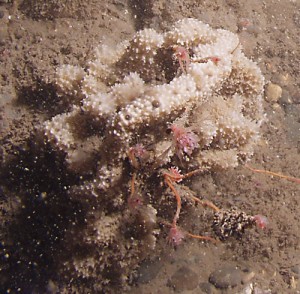Lune Deeps Dive October 2010
The Lune Deeps are not known for crystal clear visibility. To dive here you have to have the right weather, the right tides, and these have to coincide with time that you can spare to go diving. I have to admit that it would be a first for me. So I was very lucky to get a phone call from Ian at Darwen SAC inviting me on a survey dive in the Deeps. This did mean getting up at 4:00 am a couple of days later on an October Sunday morning, in order to get to Knott End in time to launch for the high tide slack water, but these opportunities don’t come up very often and I grabbed it while I could.
Setting up gear in the car park, it had the feeling of a night dive in the dark. Boats launched, we set off for the chosen site with the sun rising above Blackpool, turning the sky over the bay shades of pink. Fantastic – as a diver what more can you ask for?
Well there’s the dive. The plan was to drop to the sea bed at about 10m just out of the deeps, and to swim over the edge and down the slope; each buddy pair to have a surface marker buoy visible. Things went pretty much to plan for us, we found the sea bed and managed to work down the slope to 30m. We could have gone deeper but my – borrowed – computer had run out of no-stop time and I was wary of running it into decompression.

So, what was it like? Where we started the sea bed had quite a few fist sized pebbles and was silty enough that any misplaced fin kick would reduce visibility to zero; this wasn’t too much of a problem as the tide was running fast enough to move us smartly along and clear the silt away. At the end of the dive we got a glimpse of a clearer, more gravelly sea bed. Throughout one of the most striking things was that the dominant species was bryzoan Hornwrack Flustra foliacea, which is quite an unusual habitat to find yourself diving. The silt covering meant that much of the benthic fauna was difficult to discern, but there was still plenty to see, with numerous Coryphella nudibranchs and even a large Triton Sea Slug Tritonia hombergi. As well as some butterfish and a greater pipefish we did find an area with quite a few goldsinny wrasse, which was a bit of a surprise; several people reported seeing large dogfish.

An interesting dive, but considering the size of the area that we covered there is still plenty of the deeps undived and waiting to be explored. Would I do it again – certainly.
Posted: November 8th, 2010
Posted in Uncategorized
